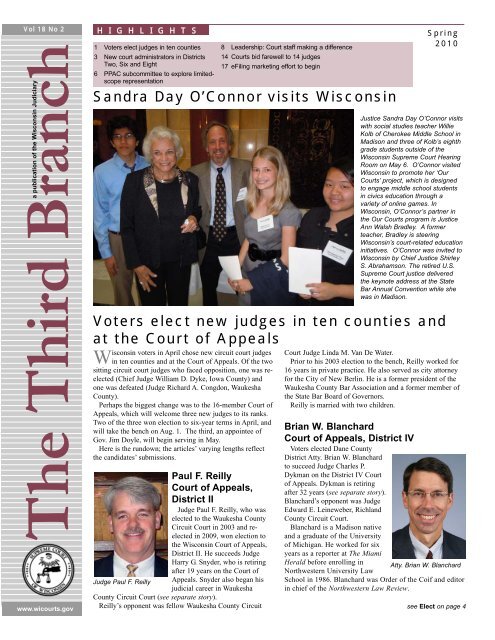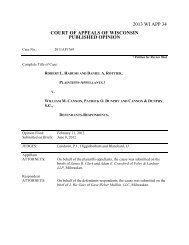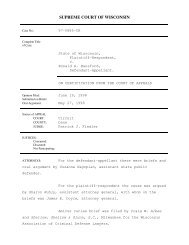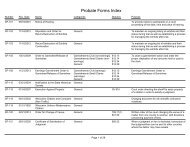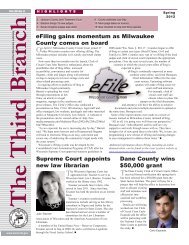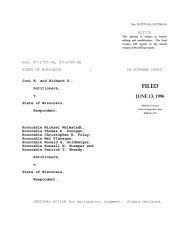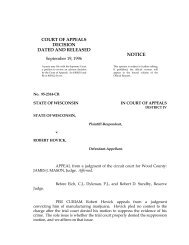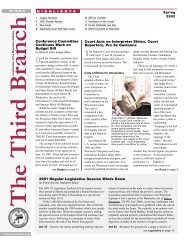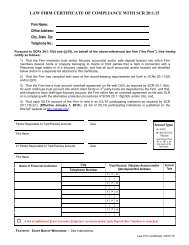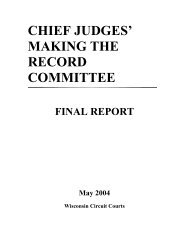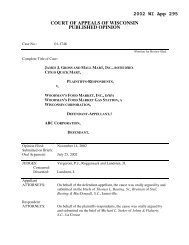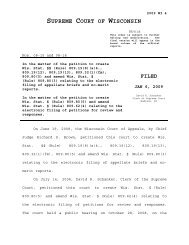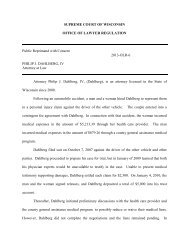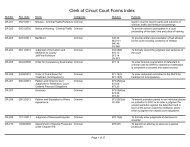Third Branch, srping 2010 - Wisconsin Court System
Third Branch, srping 2010 - Wisconsin Court System
Third Branch, srping 2010 - Wisconsin Court System
You also want an ePaper? Increase the reach of your titles
YUMPU automatically turns print PDFs into web optimized ePapers that Google loves.
Vol 18 No 2The <strong>Third</strong> <strong>Branch</strong>a publication of the <strong>Wisconsin</strong> Judiciarywww.wicourts.govH I G H L I G H T S1 Voters elect judges in ten counties3 New court administrators in DistrictsTwo, Six and Eight6 PPAC subcommittee to explore limitedscoperepresentation8 Leadership: <strong>Court</strong> staff making a difference14 <strong>Court</strong>s bid farewell to 14 judges17 eFiling marketing effort to beginSandra Day O’Connor visits <strong>Wisconsin</strong><strong>Wisconsin</strong> voters in April chose new circuit court judgesin ten counties and at the <strong>Court</strong> of Appeals. Of the twositting circuit court judges who faced opposition, one was reelected(Chief Judge William D. Dyke, Iowa County) andone was defeated (Judge Richard A. Congdon, WaukeshaCounty).Perhaps the biggest change was to the 16-member <strong>Court</strong> ofAppeals, which will welcome three new judges to its ranks.Two of the three won election to six-year terms in April, andwill take the bench on Aug. 1. The third, an appointee ofGov. Jim Doyle, will begin serving in May.Here is the rundown; the articles’ varying lengths reflectthe candidates’ submissions.Paul F. Reilly<strong>Court</strong> of Appeals,District IIJudge Paul F. Reilly, who waselected to the Waukesha CountyCircuit <strong>Court</strong> in 2003 and reelectedin 2009, won election tothe <strong>Wisconsin</strong> <strong>Court</strong> of Appeals,District II. He succeeds JudgeHarry G. Snyder, who is retiringafter 19 years on the <strong>Court</strong> ofAppeals. Snyder also began hisjudicial career in WaukeshaCounty Circuit <strong>Court</strong> (see separate story).Reilly’s opponent was fellow Waukesha County CircuitSpring<strong>2010</strong>Justice Sandra Day O’Connor visitswith social studies teacher WillieKolb of Cherokee Middle School inMadison and three of Kolb’s eighthgrade students outside of the<strong>Wisconsin</strong> Supreme <strong>Court</strong> HearingRoom on May 6. O’Connor visited<strong>Wisconsin</strong> to promote her ‘Our<strong>Court</strong>s’ project, which is designedto engage middle school studentsin civics education through avariety of online games. In<strong>Wisconsin</strong>, O’Connor’s partner inthe Our <strong>Court</strong>s program is JusticeAnn Walsh Bradley. A formerteacher, Bradley is steering<strong>Wisconsin</strong>’s court-related educationinitiatives. O’Connor was invited to<strong>Wisconsin</strong> by Chief Justice ShirleyS. Abrahamson. The retired U.S.Supreme <strong>Court</strong> justice deliveredthe keynote address at the StateBar Annual Convention while shewas in Madison.Voters elect new judges in ten counties andat the <strong>Court</strong> of AppealsJudge Paul F. Reilly<strong>Court</strong> Judge Linda M. Van De Water.Prior to his 2003 election to the bench, Reilly worked for16 years in private practice. He also served as city attorneyfor the City of New Berlin. He is a former president of theWaukesha County Bar Association and a former member ofthe State Bar Board of Governors.Reilly is married with two children.Brian W. Blanchard<strong>Court</strong> of Appeals, District IVVoters elected Dane CountyDistrict Atty. Brian W. Blanchardto succeed Judge Charles P.Dykman on the District IV <strong>Court</strong>of Appeals. Dykman is retiringafter 32 years (see separate story).Blanchard’s opponent was JudgeEdward E. Leineweber, RichlandCounty Circuit <strong>Court</strong>.Blanchard is a Madison nativeand a graduate of the Universityof Michigan. He worked for sixyears as a reporter at The MiamiHerald before enrolling inNorthwestern University LawAtty. Brian W. BlanchardSchool in 1986. Blanchard was Order of the Coif and editorin chief of the Northwestern Law Review.see Elect on page 4
2Spring<strong>2010</strong>THE THIRD BRANCHDirector’s column: The legislative season endsBy A. John Voelker, Director of State <strong>Court</strong>sEach spring, baseball coaches at every level of the gamedevelop strategies for the new season. Similarly, at thebeginning of each legislative session, the court systemdevelops a strategy to accomplish its legislative goals.With the start of a new baseball season and the end ofanother legislative sessionupon us, it seems like a goodtime to look back to see whatwe accomplished.Due in part to the state’sfinancial difficulties, we didnot achieve all that we hadhoped this session. Forexample, we put on hold anyproposals to add judgeships.But I’m happy to reportsuccess in achieving many ofthe goals established by theA. John VoelkerLegislative Committee of theJudicial Conference – goalsaimed at providing more efficient use of judicial resourcesand improving the administration of justice.This agenda represents just one aspect of my office’slegislative efforts; often, we are also called on to support oroppose someone else’s proposal. For example, we recentlyworked with legislators and built support among advocacygroups to significantly modify a proposal that would havecreated an unnecessary burden for judges handlingtemporary restraining orders and injunctions.The nature of the legislative process requires us to keep aconstant watch on legislative developments and to workyear-round to build strong relationships with legislators.When the time comes, we need to be prepared to develop astrategy and react quickly.That’s true to some extent with our own initiatives, but theagenda adopted by the Legislative Committee also offers usan opportunity to be more proactive. We are able to pursueissues we know are important to judges and courts, such asa reduction in unnecessary proceedings and paperwork.Here are some of the highlights from the <strong>2010</strong>-11legislative session:Information sharing to assist in child welfareSenate Bill 375, which is nearing final consideration,would permit the director of state courts, the juvenile courtand the Department of Children and Families (DCF) toenter into an agreement to allow for the transfer ofelectronic records that are contained in the CCAP system toDCF and for the transfer of electronic records that arecontained in SACWIS (Statewide Automated Child WelfareInformation <strong>System</strong>) to the Director of State <strong>Court</strong>s Office.The agreement must specify what types of information maybe transferred. These proposals were headed toward finalapproval at publication time.We are fortunate that the legislators who chair keycommittees are receptive to our ideas on how to improve thecourts. We also had the advantage of judges willing to takethe time to review the bills for potential problems. Theyhelped our “batting average” this legislative session, and Ithink we won more than we lost.With the exception of a clean-up session, this legislativesession has come to a close. But we will continue to stay ontop of our game and monitor developments.Joint Review Committee on CriminalPenaltiesWhen the criminal penalty statutes were revised as part ofTruth-in-Sentencing, the Legislature created the JointReview Committee on Criminal Penalties. This committeewas to report how legislative proposals would fit into thepenalty structures and categories of crimes created in 2001Act 109. Unfortunately, the committee never met and billsweren’t referred for review. Thanks in part to ourprompting, the committee is meeting, and we have providedtestimony on several bills considered by the committee.Probation supervision in second- and thirdoffenseOWI casesStatutes limited the effectiveness of courts in dealingwith repeat drunk drivers by preventing probation until thedefendant was accused of at least a fourth offense. <strong>2010</strong>Act 100, effective July 1, <strong>2010</strong>, allows the court to imposemore restrictive conditions on the second and third offenseOWI offenders and allow the court to more closelymonitor their behavior.Pilot treatment program for second- andthird-offense drunk driversIn the 2005 legislative session, the Legislature gavestatutory authority for Winnebago County to establish apilot program to offer incentives for OWI offenders to seektreatment. The pilot has been successful in promotingtreatment and saving money on jails. <strong>2010</strong> Act 100expanded statutory authority to all counties to establish thistype of program.OAR procedures and penalties<strong>Wisconsin</strong> has a large number of drivers with suspendedor revoked licenses, leading to substantial operating aftersuspension and operating after revocation violations. Theseviolations require significant judicial resources to process.Some actions that can lead to suspension do not involveviolations of rules of the road. Failure to pay non-trafficfines or forfeitures, for instance, can lead to suspension of adriver’s license. The statutes also currently require theDepartment of Transportation to administratively revoke thelicense of a driver with four operating after suspensionviolations, regardless of whether these violations wererelated to the rules of the road.<strong>2010</strong> Act 8 allows a discretionary, rather than mandatory,suspension for violations of the controlled substance law.Other legislation affecting OAR also was approved: <strong>2010</strong>Act 17 requires that courts extend the opportunity todefendants to pay traffic forfeitures in installments beforeordering suspension of drivers licenses; 2009 Act 103streamlines procedures for license reinstatement.see Director’s column on page 11
District Eight welcomes new management teamThe Eighth Judicial District, headquartered in Green Bay,is welcoming a new chief judge, deputy chief judge, anddistrict court administrator.Brown County Circuit <strong>Court</strong> Judge Donald R. Zuidmulderis the new chief judge; OcontoCounty Circuit <strong>Court</strong> JudgeMichael T. Judge is the newdeputy chief; and John Powell isthe new district courtadministrator.The Supreme <strong>Court</strong> appointedZuidmulder to succeed ChiefJudge Sue E. Bischel, whostepped down because demandsof the trial bench, communityactivities and familyChief Judge Donald R.Zuidmuldercommitments did not allow hersufficient time to devote to chiefjudge duties. Bischel remains aBrown County Circuit <strong>Court</strong> judge, and Zuidmulder willserve the remainder of her term, which runs through July 31.Zuidmulder was elected to the bench in 1997 after a 22-year career in private practice. He also served as BrownCounty district attorney, and as a deputy attorney general.He recently won a ‘Spirit of Leadership’ award from acoalition of faith groups for his “vision and leadership” inestablishing and securing funding for the new BrownCounty Drug <strong>Court</strong> program.Zuidmulder appointed Judge Michael T. Judge, OcontoCounty Circuit <strong>Court</strong>, to serve as his deputy. Judge waselected to the bench in 2005 afterworking for 32 years in private practice.He succeeds Judge D. Todd Ehlers, whowas Bischel’s deputy and who alsoserved on an interim basis as chief judge.Completing the management team isDistrict <strong>Court</strong> Administrator JohnPowell, who joined the <strong>Wisconsin</strong> courtsystem in March (see Powell’s bio inseparate story).Chief judges are responsible forsupervising judicial administrativebusiness in each of the state’s tenjudicial districts. With the exception ofJudge Michael T. JudgeMilwaukee, where the chief judge is afull-time administrator, chief judges and their deputiesmaintain court calendars in addition to handlingadministrative matters.The Eighth Judicial District encompasses Brown, Door,Kewaunee, Marinette, Oconto, Outagamie and Waupacacounties. •<strong>Court</strong> administrators bring wealth ofexperience to Districts Two, Six and EightThree of <strong>Wisconsin</strong>’s ten judicial administrative districtshave welcomed new administrators recently. Two of themen came to <strong>Wisconsin</strong> from the West Coast; the other willarrive soon from Florida. All three bring years of experiencein court management.Andrew M. GraubardDistrict TwoIn his 24 years with Florida’s Eleventh Judicial Circuit(the fourth largest trial court inthe nation, with 124 judges and700 court staff), Andrew M.Graubard has developed anaffinity for project managementand working with technology.Graubard, who will start asdistrict court administrator in<strong>Wisconsin</strong>’s Second JudicialDistrict in early June, is currentlydirector of emergencymanagement and court continuity,and assistant director of thecourt’s technology division. Hemanages 35 professional staff anda $4 million budget.Andrew M. GraubardGraubard began his career with the Florida courts as apart-time file clerk in probate court. He then became asystems analyst and programmer, and went on to bepromoted to management positions in the AdministrativeOffice of the <strong>Court</strong>s.The Second District encompasses Kenosha, Racine andWalworth counties. The court administrator post has beenvacant since Kerry Connelly resigned one year ago; District<strong>Court</strong> Administrators Beth Bishop Perrigo and MichaelNeimon have worked with Chief Judge Mary K. Wagner tokeep the office running.Ronald E. LedfordDistrict SixA little more than two years ago, Ronald E. Ledford – aformer Marine who has worked for more than 25 years incourt management – quietly took office as district courtadministrator in District Six, which is headquartered inStevens Point and encompasses Adams, Clark, Columbia,Dodge, Green Lake, Juneau, Marquette, Portage, Sauk,Waushara and Wood counties.Ledford succeeded Susan Byrnes,who moved to District Nine.Raised in the mountains ofwestern North Carolina, Ledfordbegan his court career in Illinois,where he served as an electedclerk of court and eventually aspresident of the IllinoisAssociation of <strong>Court</strong> Clerks.During his tenure in Illinois,Ledford found himself relyingupon the <strong>Wisconsin</strong> courts forprogram models and ideas.Ronald E. Ledfordsee Administrators on page 9THE THIRD BRANCHSpring<strong>2010</strong>3
4Spring<strong>2010</strong>THE THIRD BRANCHElect continued from front pageAfter law school, Blanchard clerked for the late JudgeWalter J. Cummings Jr. of the U.S. <strong>Court</strong> of Appeals,Seventh Circuit. He also served as an assistant U.S. attorneyfor eight years in Illinois before accepting a position at theMadison office of Quarles & Brady. Blanchard was electedDane County district attorney in 2000, and was re-elected tothat post four times.Blanchard and his wife, Mary, who works for a renewableenergy company, have three children, ages 14, 12 and 10.Gary Sherman<strong>Court</strong> of Appeals, District IVState Rep. Gary Sherman, a Democrat from the BayfieldCounty community of Port Wing, was appointed to fill thevacancy created by Judge Burnie L. Bridge’s retirementfrom the District IV <strong>Court</strong> ofAppeals.Gov. Jim Doyle appointed Shermaneffective May 10. His term runsthrough July 31, 2014.Sherman has served in the stateLegislature for 12 years. During histenure, he has served on the StateSuperintendent’s Advisory Councilon Rural Schools, Libraries andCommunities; the Group InsuranceBoard; the Employee Trust FundBoard; the Governor’s Council onRep. Gary Sherman Military and State Relations; theState Tribal Justice Forum; and more.A graduate of UW-Madison and the UW Law School,Sherman is a member of the American Law Institute andformer president of the State Bar of <strong>Wisconsin</strong>. He is also aveteran who served in the U.S. Air Force in the early 1970s.James P. CzajkowskiCrawford County Circuit <strong>Court</strong>Atty. James P. Czajkowski ran unopposed to succeedJudge Michael Kirchman, who retired from CrawfordCounty Circuit <strong>Court</strong> in December after 33 years on thebench (see The <strong>Third</strong> <strong>Branch</strong>, winter<strong>2010</strong>).Czajkowski began his law career inthe U.S. Air Force Judge AdvocateCorps during the Vietnam War from1971-75. He continued his service asa judge advocate in the ActiveReserves for several years followingthe war, while practicing law inPrairie du Chien. Czajkowski hasworked in private practice for 34years. He has also served as a courtcommissioner since 1999.Atty. James P. Czajkowski A graduate of UW-Madison and theUW Law School, Czajkowski hasbeen an active member of his community, serving aspresident of the Prairie du Chien Rotary Club and presidentof the board of directors of the Chamber of Commerce. Healso has been very active in conservation groups includingTrout Unlimited and the Nature Conservancy.Gary R. SharpeFond du Lac County Circuit <strong>Court</strong>Atty. Gary R. Sharpe defeatedAssistant District Atty. ScotMortier to succeed Judge StevenW. Weinke, who is retiring after24 years on the bench (aretirement story will appear in thesummer edition).A graduate of Ripon Collegeand the UW Law School, Sharpehas practiced law in Fond du Lacfor more than 33 years. He alsohas served four terms on the Fonddu Lac School Board. Since2001, he has been a volunteer onthe State Bar Fee ArbitrationPanel.Sharpe also has been active in civic organizations. He hasbeen a member of the board of directors of the local RedCross, the Fond du Lac Community Theater and the Fond duLac Oratorio Chorus.Sharpe and his wife, Gail, have three daughters. Hishobbies include reading, yard work, boating and “attemptingto train the family’s 7-month-old St. Bernard puppy Louie.”William D. DykeIowa County Circuit <strong>Court</strong>Chief Judge William D. Dyke, who has served on thebench in Iowa County for 13years, won election to a new termin April. He defeated challengerRhonda R. Hazen, a municipaljudge and volunteer mediator whopractices with a Madison lawfirm.During his tenure on the bench,Dyke has won accolades as aleader in a couple of key areas.He began the Iowa County Teen<strong>Court</strong>, which has been running for13 years, and was the first in thestate to offer mediation inforeclosure actions.Atty. Gary R. SharpeJudge William D. DykeDyke is a former Madison mayor (1969-73) who has alsoserved as a family law mediator and consultant to severalfederal agencies.Mark L. GoodmanMonroe County Circuit <strong>Court</strong>Atty. Mark L. Goodman defeated Monroe CountyCorporation Counsel Kerry Sullivan Flock in the race tosucceed Judge Michael J. McAlpine in Monroe CountyCircuit <strong>Court</strong>. McAlpine is retiring after 18 years on thebench, and will be profiled in the summer edition.McAlpine’s retirement and the creation of an additionalbranch in Monroe County mean big changes in this threebranchcircuit. Two of the three judges – Goodman and J.see Elect on page 5
Elect continued from page 4David Rice, who is profiledbelow – are new to the bench.The third, Judge Todd L. Ziegler,was elected in 2007.Goodman has worked inprivate practice in Sparta since1986. He has also been Sparta’smunicipal court judge since1992. He is currently director ofthe <strong>Wisconsin</strong> Municipal JudgesAssociation and has served as ajudge pro tempore in the Ho-Chunk Nation Tribal <strong>Court</strong>.Atty. Mark L. Goodman A graduate of UW-Madison,Goodman holds a master’sdegree from South Dakota State University and earned hislaw degree at UW Law School, where he participated in theLegal Defense Project.Goodman and his wife, Nancy, have three adult children.J. David RiceMonroe CountyCircuit <strong>Court</strong>Atty. J. David Rice ranunopposed for the newly createdbranch of the Monroe CountyCircuit <strong>Court</strong>. The Legislaturecreated <strong>Branch</strong> 3 in 2007.Rice is one of two new judgesin this three-branch circuit. Theother is Mark L. Goodman, whois profiled above.Rice has worked in privatepractice in Monroe County since1971. He has also been cityattorney for the City of Spartaand a part-time U.S. magistrate for the federal district courtin Madison. He began his career as a law clerk to then-Justice Nathan S. Heffernan in 1970-71.Rice has been very active in his community and in lawrelatedwork. He is a past president of the Sparta SchoolBoard, a member of the State Bar Board of Governors andformer president of the St. Mary’s Hospital FoundationBoard of Directors.Rice and his wife, Ann, have three adult children. Rice’suncle, the late James W. Rice, served on the bench inMonroe County for 31 years, from 1964-95.Jay N. ConleyOconto CountyCircuit <strong>Court</strong>Oconto County District Atty.Jay N. Conley will succeed JudgeRichard D. Delforge, who isretiring after 12 years on thebench (see separate story).Conley beat opponent Edward D.Burke Jr., a general practiceattorney and former assistant statepublic defender.Atty. J. David RiceAtty. Jay N. ConleyConley has been Oconto County district attorney for 19years, and has practiced law for 32 years. A graduate ofMarquette University and Marquette University Law School,Conley began his career in private practice in Oconto Falls.Conley is married to Linda and has two daughters anda son.Joseph D. BolesPierce County Circuit <strong>Court</strong>Atty. Joseph D. Boles will succeed Judge Robert W. Wing,who is retiring after 25 years on thebench (see The <strong>Third</strong> <strong>Branch</strong>, winter<strong>2010</strong>). Boles defeated Atty. Robert L.Loberg, a private practitioner fromEllsworth.A graduate of UW-River Falls andWilliam Mitchell College of Law in St.Paul, Boles has worked in privatepractice in River Falls for nearly 30years. His practice has focused oncriminal law, divorce and personalinjury cases. He also is a veteran,having served in the U.S. Air Forcefrom 1971-75.Atty. Joseph D. BolesBoles has been active in hiscommunity. He is president of the Board of Directors ofKinnic Falls Halfway House and president of the Board ofthe UW-River Falls Foundation.Boles and his wife, Della, have two grown children andthree grandchildren.Eugene A. GasiorkiewiczRacine County Circuit <strong>Court</strong>In Racine County, Atty. Eugene A. “Gene” Gasiorkiewiczwill succeed Judge Stephen A. Simanek, who is retiring after31 years on the bench (a retirement story will appear in thesummer edition). Gasiorkiewicz beat <strong>Court</strong> CommissionerGeorgia Herrera.Since 1975, Gasiorkiewicz (who added a helpfulpronouncer to his campaign letterhead: Gash-er-kev-itch) hasworked in private practice. He is aplaintiff’s lawyer focusing on personalinjury and professional negligence cases.A graduate of Regis College inDenver, Gasiorkiewicz earned his lawdegree from the University ofMississippi School of Law. He began hiscareer as a law clerk to Justice L.A.Smith Jr. on the Mississippi Supreme<strong>Court</strong>.Gasiorkiewicz has been active in avariety of professional pursuits. He hasserved as a municipal court judge and ajudicial court commissioner, and is apast chair of the Medical MediationPanels.Atty. Eugene A.GasiorkiewiczDuring the campaign, Gasiorkiewicz expressed interest inbeginning a foreclosure mediation program in Racine andstarting a special court program for veterans.see Elect on page 20THE THIRD BRANCHSpring<strong>2010</strong>5
6Spring<strong>2010</strong>THE THIRD BRANCHCriminal justice mental health task forcebegins workBy Theresa Owens, Executive Assistant to the Chief JusticeAnew statewide task force that will focus on improvingthe criminal justice system’s response to people withmental illness began its work with a summit in Madison onMarch 11.Chief Justice Shirley S. Abrahamson convened the taskforce to do three things: (1) identify current programs andinitiatives operating across the state, (2) analyze gaps in themental health and criminal justice systems, and (3) developa best-practices model of evidence-based, cost-effectiveinterventions that can be implemented early to improveresponses to people with mental illness.By Ann Zimmerman, Statewide Pro Se CoordinatorThe Supreme <strong>Court</strong> Planning and Policy AdvisoryCommittee (PPAC) voted in March to establish a newsubcommittee to focus on limited scope representation. Itswork will begin in the coming months.Limited scope representation is an attorney-clientrelationship in which the lawyer does some, but not all, ofthe work involved in the case. The client handles theremaining tasks on his or her own, sometimes with coachingfrom the lawyer. This allows otherwise self-representedlitigants, who may not be able to afford full-servicerepresentation, to obtain some legal assistance targetedwhere they need it most. Limited scope representation canalso improve court effectiveness and efficiency in that selfrepresentedlitigants may be better prepared and rely less oncourt staff.Chief Justice Shirley S. Abrahamson supported PPAC’sdecision to form the subcommittee.“For both the courts and the bar, we must identify modelsthat will help lawyers expand their ability to providenecessary legal services to litigants who cannot afford fullservicerepresentation or who want to represent themselves,”she said. “Many states have found that limited scoperepresentation can be a useful option when encouraged byThis project is part of a national effort called the ChiefJustices’ Criminal Justice Mental Health LeadershipInitiative. The Council of State Governments’ Justice Centerselected <strong>Wisconsin</strong> through a competitive process toparticipate. The Chief Justice Initiative is a national projectdesigned to encourage collaborative efforts and assist statesupreme court justices in guiding efforts in their state toimprove the response to people with mental illnesses in thecriminal justice system.see Task force on page 16PPAC creates Limited Scope RepresentationSubcommitteeA $5,000 grant from the State Bar Legal AssistanceCommittee to Judicare will help to launch a pilot program toenable eligible Judicare clients to ask questions of pro bonoattorneys online.The Internet legal advice system will rely upon anadministrator and volunteer attorneys. Judicare will fill theadministrator role and the <strong>Wisconsin</strong> Tenth District Self-Represented Litigants Committee will assist Judicare inrecruiting attorneys and publicizing the Web site.The program will make use of software designed by LegalServices of Northern Michigan and Legal Services ofNorthwest Minnesota to create a Web site where selfrepresentedlitigants and residents with unmet legal needscan receive legal advice. The grant money will be used tothe courts and bar and supported with training, riskmanagementmaterials and court rules and forms.”Since 2004, PPAC has consistently identified as a toppriority the issue of self-represented litigation, and inresponse the <strong>Wisconsin</strong> court system has implemented aspectrum of initiatives to provide self-represented litigantsaccess to justice and effectively manage internal resources.These initiatives include statewide pro se forms, judicialeducation and court staff training programs, collaborativepartnerships with public libraries and technology-basedresources for court staff and litigants.The new subcommittee will research and discuss thefeasibility of developing a statewide limited scoperepresentation program and make recommendations toPPAC. Research will help to document current efforts in thisarea throughout the state and nation with a focus onidentifying gaps and avoiding duplication of work alreadyunderway. •For further information, contact Ann Zimmerman at (608)261-8297 or ann.zimmerman@wicourts.gov or Shelly L.Cyrulik at (608) 266-8861 or michelle.cyrulik@wicourts.gov.Pilot program will help answer legalquestions onlinemodify the software for use in <strong>Wisconsin</strong>, to recruitvolunteer attorneys and to publicize the Web site.“This project is an excellent example of how civil equaljustice in <strong>Wisconsin</strong> can be achieved for disadvantagedpeople and communities through the collaborative efforts oflawyers, courts and other organizations,” said ChippewaCounty Clerk of Circuit <strong>Court</strong> Karen Hepfler, chair of theTenth District Self-Represented Litigants Committee.The 18-month pilot will initially target eligible Judicareclients in four northern counties in the Tenth JudicialDistrict: Ashland, Bayfield, Sawyer and Washburn. Ifsuccessful, it will likely be extended into other judicialdistricts covered by Judicare. •
Effective justice strategies researchproject underwayBy Erin Slattengren, Special Project Manager, Office of <strong>Court</strong> OperationsThe Director of State <strong>Court</strong>s Office has contracted withthe National Center for State <strong>Court</strong>s (NCSC) toundertake a research project on effective justice strategies.The goals are (1) to identify court-related evidence-basedstrategies that enhance public safety, reduce recidivism andaddress criminal and addictive behaviors, and (2) to developrecommendations related to the court system’s role infostering statewide support and replication of these strategies.Over the past several planning cycles, the Supreme <strong>Court</strong>Planning and Policy Advisory Committee (PPAC) identified“sentencing reforms and strategies to reduce recidivism” asa top priority. In response, we have sought grant funding toassist our office in identifying the court-based programs thatexist throughout <strong>Wisconsin</strong> that are using evidence-basedpractices in addressing local justice system issues.Over the next year, the NCSC will gather information toassist us in answering the following questions:What is currently being done in <strong>Wisconsin</strong> courts?Gain an understanding of programs, initiatives andoutcome measures currently being utilized in <strong>Wisconsin</strong>courts related to public safety/problem solving strategies,reducing recidivism and alternatives to incarceration.What works and how do we measure it?Determine the most effective and fundamental componentsof these alternative sentencing practices, programs andDistrict trainings focus on safe exchange incases involving domestic violenceBy Donna Erez, Children’s <strong>Court</strong> Improvement ProgramThis fall, each judicial district will offer a one-dayworkshop for judges and court commissioners entitledAvoiding Tragedy: Keeping Kidsand Victims Safe in FamilyInteractions. Faculty memberswill include Judges ChristopherR. Foley, Milwaukee County, andDale T. Pasell, La Crosse County;Norma Ginther, a national experton attachment, child developmentand visitation; and Sandy Stetzer,Visitation Center supervisor at theChildren’s Service Society of<strong>Wisconsin</strong>.Workshop participants willJudge Christopher R.learn:Foley• the importance of familycontact to healthy child development and attachment;• safe family interaction principles in child welfare andfamily law cases;• the effects of domestic violence on safe exchange andfamily interaction;• strategies to keep children and abused caregivers safe;and• how to identify and develop resources to implementsafe family interaction strategies.innovative problem-solving strategies and makerecommendations on how to assess ongoing effectiveness,and foster replication of programmatic outcomes throughoutthe court system.What should be the statewide strategy andplan of action?Make specific recommendations to the director of statecourts and PPAC about education and outreach strategies topromote further development of best practices statewide andfoster system improvement. These entities will utilize theserecommendations as a “road map” to communicate needs toleadership on the state level including but not limited to thegovernor and Legislature.The NCSC conducted an initial survey of all circuit courtsin April. This survey went out to all chief judges, presidingjudges and district court administrators. A more detailedfollow-up survey and/or interview will be conducted shortlywith some individuals in order to gain additionalinformation about specific program types. In addition toadministering the survey, the NCSC will be conducting sitevisits in approximately 15 counties throughout the state thisfall.We will keep you informed of the progress of this excitingproject. Please address questions to me at (608) 261-0684 orerin.slattengren@wicourts.gov. •The trainings will take place on the following dates:Districts 6 and 9: Tuesday, Sept. 21, Holiday InnConvention Center, Stevens PointDistrict 10: Thursday, Sept. 23,Heartwood Conference Center,TregoDistricts 4 and 8: Wednesday,Sept. 29, Radisson Paper ValleyHotel, AppletonDistricts 5 and 7: Thursday, Sept.30, House on the Rock Resort,Spring GreenDistricts 2 and 3: Thursday, Oct.7, Civil War Museum, KenoshaDistrict 1: Friday, Oct. 8,<strong>Wisconsin</strong> Club, MilwaukeeJudge Dale T. PasellThe training is made possible by the Director of State<strong>Court</strong>s Office STOP Grant and the Children’s <strong>Court</strong>Improvement Program. •For more information, contact Erin Slattengren, specialprojects manager, at erin.slattengren@wicourts.gov orMichelle Jensen Goodwin, Children’s <strong>Court</strong> ImprovementProgram director, at michelle.jensengoodwin@wicourts.gov.THE THIRD BRANCHSpring<strong>2010</strong>7
8Spring<strong>2010</strong>THE THIRD BRANCHLEADERSHIP<strong>Court</strong> staffers make a differenceacross <strong>Wisconsin</strong>Across the state, in spite of economic woes that have hithome, <strong>Wisconsin</strong> court system staffers are stepping upin all sorts of ways to make a difference in the lives ofothers. Here are the stories of three court employees who arecontributing to their communities in very different ways.Atty. Karla BaumgartnerManager of Municipal Judge Education, andeditor of the <strong>Wisconsin</strong> BenchbooksThe list of “special needs” horses that KarlaBaumgartner has rescued, rehabilitated on her Justice-B-Dun Ranch and placed for adoption grows longer and moreimpressive each year.The first rescue was Cloud, a starving horse from SouthDakota whose owner fell on hard times and couldn’t affordproper feed. Next came Jones, who had a crooked leg thatBaumgartner and an expert farrier (a hoof trimmer) managedto correct. Soon after came Seymour, a horse so painfullyshy that he was too timid to compete with the other younghorses for his share of grain. Then there was Dillon, a horsefrom Wyoming with a benign tumor in his brain thatrequires expensive medication. And a wild mustang, K.C.,that had never been touched by a human. Then, a year ago,Baumgartner got word that 27 horses had been found halfstarvedon an abandoned farm in Trempealeau County. Sheoffered to take two of them.“When the trailer pulled up and I looked inside, it was justheartbreaking,” she recalled. “They were so pathetic,standing therewith no energy,just skin andbones.”Today, thosetwo horses – amother and sonwith rare,champagnecoloredcoats –are big, strongand healthy. AfterBaumgartnerrehabilitatedthem she wasable to placethem in goodhomes.“It used to beeasy to findhomes forhorses,” she said,“but that’s nolonger true in thiseconomy. I wasreally pleasedthat we were ableto place theseAbove is Slim, just after KarlaBaumgartner rescued him from a herd of27 that were discovered starving to deathon a northern <strong>Wisconsin</strong> ranch.This is Slim today.two.”Right now,Baumgartner –an attorney whodirects themunicipal judgeeducationprogram andedits the five<strong>Wisconsin</strong>Benchbooks –has a total of 11horses in herstables on 16acres in RockCounty’s UnionTownship. Theygo through 33Karla Baumgartner with two of her horses.These two are 30 years old; Baumgartnerhas had them for 29 years.tons of hay in a year, and (mostly) peacefully coexist with amenagerie of dogs, cats, geese, chickens and a rabbit.Baumgartner’s husband, Evansville Municipal <strong>Court</strong>Judge Thomas J. Alisankus, is perhaps more enthusiasticabout the farm itself than the animals – a severe allergy tohorses limits his contact with them and, although he iscompletely supportive of Baumgartner’s rescue efforts, hemore often then not refers to the horses as Baumgartner’s“juvenile delinquents.” Alisankus’ allergy means he doesmore of the heavy lifting and farm machinery operation, andBaumgartner spends extra time caring for the animals.“I get up at 5 a.m. to do chores, and it’s just so peaceful towatch the sun come up and to be with these beautifulanimals,” she said. “I’m just so fortunate. I am living mydream.”Crystal BrumleyDeputy ClerkDane County Clerk of Circuit <strong>Court</strong> OfficeFor the past decade, Deputy Clerk Crystal Brumley, DaneCounty Clerk of Circuit <strong>Court</strong>s Office, has dedicated herselfto collecting thousands of dollars for local charities throughpenny jars, soda sales, pet photo contests and more.Clerk of Circuit <strong>Court</strong> Carlo Esqueda calls Brumley “Ourone-woman Sunshine Club.” He shared the following notefrom the director of Orion Family Services, the beneficiaryof one of Brumley’s fundraising efforts:Seven boys and several staff members from theAkasha group home are on their way to Chicagofor a field trip ... underwritten by a portion of yourdonation. The itinerary includes a visit to theMuseum of Science and Industry and the SheddAquarium. I am sure that it is a first for all ofthese kids (and probably one or two of the staff). Itwas a great feeling to be able to say yes...see Leadership on page 9
LEADERSHIP continued from page 8When Brumley joined the office 11 years ago, she hadnever organized a charity fundraiser. That changed when asupervisor asked if she might be interested in participatingin the United Way Combined Campaign.“I seemed to take a liking to it,” she said.Enthusiastic colleagues keep Brumley motivated – andensure the continued success of a variety of fundraisinginitiatives.Those initiatives include a silent auction/bake sale forwhich Brumley and her co-workers donate new or gentlyused items with proceeds going to the Rainbow Project; anannual pet photo contest with gift cards from local pet storesas prizes with proceeds going to WAGS and Dane CountyHumane Society; a penny jar fund drive with proceeds goingto the Second Harvest Food Bank; and soda sales benefitingOrion Family Services.The side benefit of these many diverse initiatives iscamaraderie among the office’s employees.“I work with a wonderful group of people,” Brumley said.“The staff of the Clerk of <strong>Court</strong>s Office is very, very generousand giving, (so) the events are always a huge success. And weknow that we’re helping out our fellow neighbors (thecharities we donate to) who need a helping hand.”Art SaffranSenior technical support engineerCCAPArt Saffran’s life changed in 2004, when – at age 49 – heran his first marathon. The run took place in Anchorage,Alaska, as part of the Team in Training fundraising programof the leukemia and Lymphoma Society.“I ran that marathon in memory of my best friend whodied from Leukemia after a five-year struggle,” he said. “Iam constantly surprised by the number of people whoselives have been touched by some form of blood cancer. Infact, my colleague Robbie Brooks, who was known acrossthe state, passed away alittle more than a year agofrom lymphoma.”Around the time of thatfirst marathon, Saffran lefthis 20-year position at theState Bar, where he led theComputer ServicesDepartment, to join theConsolidated <strong>Court</strong>Automation Programs(CCAP). Today, hebalances that work with hisown consulting firm andvolunteer commitmentsthat continue to grow.“I now serve as afundraising mentor to Teamparticipants and a runcoach for the Madisonchapter,” Saffran said. “Ihave also been nominatedto participate in theMadison chapter’s Man &Woman of the Yearcampaign, a friendlyArt Saffran, a senior technicalsupport engineer at CCAP,crosses the finish line at the 2005Chicago Marathon. Saffran beganrunning marathons in 2004 toraise money for the Leukemia andLymphoma Society.fundraising competition in which several men and womencompete to see who can raise the most money for leukemiaresearch in a 10-week period.”Saffran’s fundraising goal is $15,000. He plans tosee Leadership on page 20THE THIRD BRANCHSpring<strong>2010</strong>9Administrators continued from page 3“As a clerk, I often looked to the courts of <strong>Wisconsin</strong> asone of the leaders in developing and implementing effectivecourt management,” Ledford said. “So it’s exciting to nowbe part of an organization that has such a rich history ofexcellence.”Ledford also got to know former District Six DCA SamShelton in the mid 1980s when they both went to China aspart of a National Center for State <strong>Court</strong>s delegation.After he left Illinois, Ledford was as court administrator inAustin, Texas, and then in the state of Washington. He saidhe has developed a special interest and expertise inevaluating, developing and implementing business systemsthat are effective, efficient and economical.A graduate of Southern Illinois University, Ledford alsoserved in the U.S. Marine Corps as a helicopter crew chief.He was deployed to the USS Guadalcanal for three years.Ledford and his wife, Sue, a deputy clerk of court who iscurrently job hunting, have three children and threegrandchildren.John PowellDistrict EightDistrict <strong>Court</strong> Administrator John Powell joined theEighth Judicial District in March. District Eightencompasses Brown, Door, Kewaunee, Marinette, Oconto,Outagamie and Waupaca counties.Powell came to <strong>Wisconsin</strong> from the state of Oregon,where he was first a court administrator and then atechnology specialist. Powell’s work as an analyst on theOregon e<strong>Court</strong> Readiness Project prior to coming to GreenBay involved helping trial courts throughout the state toprepare for implementation of various projects associatedwith the Oregon e<strong>Court</strong> program, a major multi-yearprogram to upgrade court technology.Prior to his position in Oregon, Powell worked as a courtadministrator in Reno, Nev., where he also served as vicepresident of the Nevada Association of <strong>Court</strong> Executives.Before he took the job in Nevada, Powell worked as a courtadministrator in Rochester, Minn., and Lawrence, Kan.Powell is also a veteran. He served from 1979-92 in theU.S. Army in a number of infantry, special forces and publicaffairs assignments.A graduate of the University of Iowa, Powell earned amaster’s degree from Baker University in Kansas in 1992.He and his wife, Leslie, have a blended family includingadult children and two dogs.Powell’s interests include history, building scale models,photography, drawing, stamp collecting and hiking. •
10Winter<strong>2010</strong>THE THIRD BRANCHAWARDSThree Eau Claire judges selected fortop honorsThe State Bar of <strong>Wisconsin</strong> selected two Eau Clairejudges for its most prestigious annual awards, while the<strong>Wisconsin</strong> Law Journal named a third as one of its <strong>2010</strong>‘Women in the Law’.Reserve Judge Thomas H. Barland received the 2009 StateBar Lifetime Jurist Achievement Award, while Chief JudgeBenjamin D. Proctor was honored with the 2009 Judge ofthe Year Award at a ceremony in Madison. Judge Lisa K.Stark will be honored along with 20 other women at aceremony on May 21 in Milwaukee. The Women in the LawAward honors “outstanding achievement by the top womenin the practice of law,” according to the Law Journal.Lifetime Jurist Achievement AwardReserve Judge Thomas H. BarlandBarland is one of <strong>Wisconsin</strong>’slongest-serving judges, and hiswork has had a profound impacton the justice system. He took thebench in Eau Claire County in1967 and served there until hisretirement in 2000. Barlandcontinues to handle a variety ofcases as a reserve judge, and alsoworks on projects to addressissues such as jail overcrowding.Barland is the first Eau ClaireJudge Thomas H.Barlandjudge to win the Lifetime JuristAchievement Award.Judge of the Year AwardChief Judge Benjamin D. ProctorThe winner of the Judge of theYear Award, Proctor, was firstelected to the bench in Eau ClaireCounty in 1988. He was reelectedin 1994, 2000 and 2006.In 2005, the Supreme <strong>Court</strong>selected him to serve as chiefjudge for the Tenth JudicialDistrict. In addition to his chiefjudge duties, Proctor continues tohandle a caseload in Eau ClaireCounty Circuit <strong>Court</strong>.Women in the Law AwardJudge Lisa K. StarkChief Judge Benjamin D.ProctorIn her 10 years on the bench in Eau Claire, Stark hasdedicated herself to finding better, smarter ways to addresscrime and recidivism. Her hard work earned her two awardsthis spring. The <strong>Wisconsin</strong> Law Journal will honor Starkwith its Women in the Law Award, on the heels of herrecognition as the <strong>2010</strong> Aulik Award winner.Stark runs the Eau Claire County Drug Treatment <strong>Court</strong>Program, which opened its doors in 2004. This spring, the<strong>Wisconsin</strong> Association of Drug Treatment <strong>Court</strong>Judge Lisa K. Stark poses with Chief Justice Shirley S.Abrahamson and Chief Judge Benjamin D. Proctor afterreceiving the Aulik Award from the <strong>Wisconsin</strong> Association ofTreatment <strong>Court</strong> Professionals. Presenting the award was agraduate of the Eau Claire County Drug <strong>Court</strong> program,where Stark presides.Professionals recognized Stark’s extraordinary commitmentby presenting her with the Aulik Award. That award isnamed for the late Judge Jack Aulik, who created DaneCounty’s Drug Treatment <strong>Court</strong> program.Stark teaches judges across the state about developmentsin drug and alcohol treatment, and she has been a leader onthe Justice Reinvestment Initiative, a “get smart on crime”project. She now is a member of the Legislative CouncilCommittee that oversees the Justice Reinvestment Initiative.Chief Justice Shirley S. Abrahamson recently appointedStark as dean of the Judicial College.Needham namedABOTAJudge of the YearThe <strong>Wisconsin</strong> Chapter of theAmerican Board of TrialAdvocates (ABOTA) has chosenSt. Croix County Circuit <strong>Court</strong>Judge Scott R. Needham as itsJudge of the Year.The <strong>Wisconsin</strong> chapter presentsthe award each year to a memberof the <strong>Wisconsin</strong> judiciary“whose thorough preparation,breadth of knowledge of the law, decisive rulings andcourtesy to litigants, jurors and members of the bar haveconsistently advanced the interest of justice and the dignityof the judicial process,” according to the nominatingcommittee.“Judge Needham is being recognized for all thosequalities and more,” said Atty. Mark S. Young, president ofJudge Scott R. NeedhamABOTA’s <strong>Wisconsin</strong> Chapter. Young described Needham asconscientious and diligent about his legal research.Needham is deputy chief judge of the Tenth JudicialDistrict, and has been on the bench since 1994. A recognitiondinner in his honor was held May 5 in Madison.see Awards on page 11
AWARDS continued from page 10ABOTA was established in 1957 for the primarypurpose of preserving the civil jury trial. Theorganization has presented this award to a <strong>Wisconsin</strong>judge for the past 19 years. The recipient serves asthe judge in a mock trial during the trial seminarABOTA sponsors annually. Last year’s winner wasMilwaukee County Circuit <strong>Court</strong> Judge Francis T.Wasielewski.Director’s column continued from page 2Sentencing guideline worksheetsWith the sunset of the <strong>Wisconsin</strong> Sentencing Commission,sentencing guidelines were not being revised. Nevertheless, thestatutes continued to require judges to abide by the samerequirements as if the Sentencing Commission continued to exist.2009 Act 28 repealed Wis. Stat. § 973.017 (2)(a) and (10), inorder to bring current statutes in line with the reality of sentencingpractices.THE THIRD BRANCHSpring<strong>2010</strong>11<strong>Wisconsin</strong> judges, court staffnamed Leadersin the LawThe <strong>Wisconsin</strong> LawJournal recognized itsLeaders in the Law for<strong>2010</strong> at an event in lateFebruary. Among thewinners were MilwaukeeCounty Circuit <strong>Court</strong>Judge M. Joseph Donald,Milwaukee Municipal<strong>Court</strong> Judge Derek C.Mosley and MilwaukeeJustice CenterAdministrator Dawn R. Caldart.‘Best of’ list includes state judgesThe <strong>Wisconsin</strong> Law Journal’s annual survey of itssubscribers yielded a lengthy ‘Best of’ section thatincludes a number ofrepeat winners.<strong>Wisconsin</strong> Supreme<strong>Court</strong> Chief Justice ShirleyS. Abrahamson won the‘Best Supreme <strong>Court</strong>Justice’ title, while <strong>Court</strong>of Appeals Chief JudgeRichard S. Brown wasvoted ‘Best <strong>Court</strong> ofAppeals Judge’ andMilwaukee County Circuit<strong>Court</strong> Judge John DiMottotook ‘Best Circuit <strong>Court</strong>Judge’ honors. •Judge Richard S. BrownJudge M. Joseph DonaldChief Justice Shirley S.AbrahamsonJudge John DiMottoUnnecessary proceduresSome statutory requirements create the need for additional orlonger court proceedings, without providing greater protection fordefendants or for the public. For example, judges were required toadvise defendants, both orally and in writing, of “bad time”consequences. Because of the thousands of sentencing hearingsheld every year, the cumulative amount of time and resourcesspent on this task was substantial. The oral notification waseliminated by 2009 Act 28.John Doe proceedingsWe set out to clarify judicial discretion in John Doe proceedings.Statutes allow a person to petition the court directly for a John Doeproceeding if he or she believes a crime has been committed andthe district attorney has failed to bring a criminal action. However,statutes gave the court little discretion on how to deal with JohnDoe petitions. 2007 Act 24, approved in June 2009, amendedstatutes to allow the court to determine whether a petition hasprosecutorial merit before being required to schedule a hearing.If you have ideas for legislative change that would help the courtsystem next legislative session, please send them to LegislativeLiaison Nancy Rottier, nancy.rottier@wicourts.gov or (608) 267-9733. It’s never too early to start preparing for next season. •New catalog detailscourt-volunteerprogramsMore than a decade ago, the Office of the Chief Justicedeveloped the first-ever catalog of court-related volunteerprograms operating in <strong>Wisconsin</strong>.The county-by-county roster ofinitiatives was impressive, andhelped to encourage replication ofworthy programs.The catalog was updated over time,but never completely overhauled –until now. The new Volunteers in the<strong>Court</strong>s catalog presents informationon more than 110 programs operatingacross the state. From CASAs toTeen <strong>Court</strong>s to guardianshipprograms, Volunteers in Probationand conflict-resolution centers,initiatives that involve volunteers incourt-related work are included.Theresa Owens, assistant to thechief justice, headed up the projectwith assistance from intern Alexis Bowie. The catalog is availableat www.wicourts.gov/services/volunteer/catalog.htm. •
12Spring<strong>2010</strong>THE THIRD BRANCH<strong>Wisconsin</strong> team invited to discuss state –tribal court relationsBy Shelly Cyrulik, Policy Analyst, Office of <strong>Court</strong> OperationsIn March, a team representing<strong>Wisconsin</strong> state and tribalcourts joined representatives from16 other states in Connecticut forthe Northeast Regional State-Tribal Forum called ExtendingProject Passport.Among the Forum’s goals wasto build upon the success ofProject Passport, which isdesigned to encourage states andtribes to adopt uniform dataelements and formatting of the Judge Edward R.first page of orders of protection. BrunnerUniformity improves recognitionand enforcement of orders within and between states andtribes. <strong>Wisconsin</strong> is among more than 30 states that haveimplemented these changes.Tribal courts in <strong>Wisconsin</strong> arecurrently considering adoption.I served on the <strong>Wisconsin</strong> team,along with Judge Edward R.Brunner, <strong>Wisconsin</strong> <strong>Court</strong> ofAppeals; and Judge J.D. McKay,Brown County Circuit <strong>Court</strong>.Representing the <strong>Wisconsin</strong> tribalcourts were Judge James Mohr, aformer <strong>Wisconsin</strong> circuit courtjudge who now is a member ofJudge J.D. McKaythe Lac <strong>Court</strong>e Oreilles Tribal<strong>Court</strong>, and Judge Todd Mathafrom the Ho-Chunk Nation.Brunner and Mohr participated in a panel highlightingsuccessful collaborative models from across the nation. Theydiscussed <strong>Wisconsin</strong>’s development of and experience withthe Teague Protocol, an agreement relating to allocatingjurisdiction between state and tribal courts, within the Ninthand Tenth judicial districts.We had a very strong team to review past efforts of the<strong>Wisconsin</strong> State-Tribal JusticeForum and work to identify areasof future focus. The teamdiscussed methods for improvingcommunication between state andtribal courts in light of theDiscretionary Transfer Rule, andalso considered how to improveaccessibility of tribal ordinancesand tribal court decisions.The Forum was sponsored bythe National Center for State<strong>Court</strong>s in partnership with theU.S. Department of Justice,Office of Tribal Justice, the OfficeShelly Cyrulikon Violence Against Women and its tribal unit, the NationalCongress of American Indians, and the National AmericanIndian <strong>Court</strong> Judges Association. •For more information, contact Shelly Cyrulik at (608) 266-8861 or michelle.cyrulik@wicourts.gov.OBITUARIESTerence John OwensCalumet CountyTerence J. Owens, who served as clerk of circuit court inCalumet County for 22 years, died Jan. 28. He was 75.A past president of the Clerk of Circuit <strong>Court</strong> Association,Owens was an active member of his community and aproud Irishman.He is survived by his wife, Elizabeth, along with threesons and four daughters.Mary K. StormsRichland CountyMary K. “Mema” Storms, deputy clerk of circuit court inRichland County, died March 31 at the age of 53 after abattle with cancer.Clerk of Circuit <strong>Court</strong> Stacy Kleist said Storms was aninvaluable employee and adelightful person.“She was just fun and areally hard worker,” said. “Shewas like sunshine on our floorof the courthouse.”According to her obituary,she loved gardening, mowingher lawn, working at theRichland County <strong>Court</strong>housewith her friends and coworkersand spending timewith her family and especiallyher grandchildren.Mary K. StormsSurvivors include herhusband, David; two daughters, four grandchildren, threestep-grandchildren, siblings and others. •
Milwaukee Foreclosure Mediation Programmarks first anniversaryLast spring, <strong>Wisconsin</strong> Attorney General J.B. VanHollen, Milwaukee Mayor Tom Barrett, and MarquetteUniversity Law School Dean Joseph D. Kearneyannounced the creation of the Milwaukee ForeclosureMediation Program. ChiefJudge Jeffrey Kremersfollowed by enacting adirective that requirednotice of the availabilityof mediation. By July2009, the mediationprogram was underway.Nearly one year later,the program has processedmore than 800 requests formediation. Organizersreport that requests havebeen made in about 20percent of cases.Milwaukee County hasthe highest number ofresidential foreclosures inthe state: 6,323 residentialforeclosure filings in 2009alone. In response, MayorTom Barrett convened theMilwaukee ForeclosurePartnership Initiative,which proposed usingThe Milwaukee Foreclosure Mediation Program’s <strong>Court</strong>houseWorking Group includes (bottom row, from left): Maritza AmaroHernandez, clerk of program operations; Debra Tuttle, chiefmediator; Amy Koltz, program coordinator; and (top row, from left):Jim Smith, chief deputy clerk of circuit court; Cheryl Meddaugh,secretarial assistant to the clerk of circuit court; and John Barrett,clerk of circuit court.mediation as one of a number of intervention strategies. TheLegal Aid Society, represented by Chief Staff Atty. CateyDoyle and Staff Atty. Nicole Penegor, convened a diversegroup of stakeholders to design the program. The workinggroup included lenders’ counsel, bankruptcy attorneys,housing counselors, mediators, community advocates,judges, representatives from the city of Milwaukee, andMarquette University Law School staff specializing inpublic service and dispute resolution.The program is administered as part of the law school’sdispute resolution and public service programs. It receivedfunding from the city of Milwaukee and the <strong>Wisconsin</strong>Department of Justice to provide foreclosure mediation toresidents of Milwaukee County.The program is voluntary, and both homeowner and lendermust agree to mediate. By participating, lenders providehomeowners the opportunity to tell their story and seeksolutions to an incredibly stressful situation. The mediationprocess also benefits lenders by providing a non-adversarialforum to discuss options face-to-face with the homeownerwhile protecting the lending institutions’ financial interests.The program staff—Chief Mediator Debra Tuttle, ProgramCoordinator Amy Koltz, and Maritza Amaro Hernandez,clerk of Program Operations—work out of an office in theMilwaukee County <strong>Court</strong>house provided by Clerk of Circuit<strong>Court</strong>s John Barrett. Chief Deputy Jim Smith and CherylMeddaugh, secretarial assistant, help with the program alongwith about a dozen law students who are gaining firsthandknowledge of the use of dispute resolution in a court settingand earning pro bono hours to qualify for membership in thelaw school’s Pro Bono Society.The program requiresthat homeowners meetwith a HUD certifiedhousing counselor prior tothe mediation session toensure that any discussionsthat take place duringmediation are based onobjectively supportedfinancial information.The expertise and insightsfrom the housingcounseling agencies,including HousingResources, Inc., SelectMilwaukee, AffordableHousing, MinistryEnterprises, MilwaukeeMetropolitan Fair HousingCounsel and HBC, are anintegral part of theprogram’s success.The mediation sessioncan result in agreements forrepayment plans,forbearance plans, trial modifications, permanentmodifications, listing agreement forbearance plans, orunemployment forbearance plans, depending on theindividual circumstance. The available options are variedand changing every week as additional creative solutions aredeveloped to address the foreclosure crisis. Mediation alsoserves those situations where it is clear the borrower simplywill not be able to stay in the home by providing anopportunity for the homeowner to have some control overhis/her transition out of the home.“The mediation process guides communication with itsconcrete steps,” said Chief Mediator Debra Tuttle. “This is arapidly changing environment, and mediation offers a wayfor homeowners and lenders to keep up with each other in acollaborative, efficient and productive way.”Marquette University Law School’s involvement inforeclosure mediation is not limited to Milwaukee County.Tuttle and Natalie Fleury, the law school’s programcoordinator for Dispute Resolution, trained the mediatorscurrently handling cases in Rock and Walworth counties.The law school also administers foreclosure mediation forBuffalo, Pepin, Outagamie and Waukesha counties. Themediation model is easily adapted, and the program iswilling to provide assistance to any county looking foralternatives to foreclosure. •THE THIRD BRANCHSpring<strong>2010</strong>13
14Spring<strong>2010</strong>THE THIRD BRANCHRETIREMENTS<strong>Court</strong>s bid farewell to 14 judgesIn the seven months between December 2009 and July<strong>2010</strong>, the <strong>Wisconsin</strong> court system has, or will, bidfarewell to 14 judges.In the winter edition of the newsletter, we profiled fourof them (Judge Burneatta “Burnie” L. Bridge, <strong>Wisconsin</strong><strong>Court</strong> of Appeals; and circuit court Judges MichaelKirchman, Crawford County; Michael J. McAlpine,Monroe County; and Robert W. Wing, Pierce County).In the current issue, we profile retiring <strong>Court</strong> of AppealsJudges Charles P. Dykman and Harry G. Snyder, alongwith Judges William H. Carver, Winnebago County;Richard D. Delforge, Oconto County; and Michael Gibbs,Walworth County.In the summer issue, we hope to connect with JudgesFrederick A. Henderson, Rusk County; Gary J. Langhoff,Sheboygan County; Stuart A. Schwartz, Dane County;Stephen A. Simanek, Racine County; and Steven W.Weinke, Fond du Lac County.Long-serving appeals court judge willfocus on teachingBy Stephanie Hartwig, <strong>Court</strong> Information InternOne of <strong>Wisconsin</strong>’s two longest-serving <strong>Court</strong> of Appealsjudges, Judge Charles P. Dykman, will step down thissummer, ending a 32-year career on the bench. Dykman’sdeparture will leave Chief Judge Richard S. Brown as theonly <strong>Court</strong> of Appeals judge to have served since thecreation of the court in 1978.Dykman plans on remaining active as ateacher in two very different venues.First, he will continue to teach hisimmensely popular canning class atMadison’s Willy Street Co-op in the fall,and a seed-starting class in the spring.Dykman has been teaching these classesfor 10 years. Second, he will teach anegligence seminar in fall <strong>2010</strong> at theUW Law School.“I certainly don’t want to leave the lawalone,” he said. “I don’t intend to retirefrom the law if I can manage that. Butthat of course has to do with other peoplewho may or may not find the information I’ve obtained overthis time necessary.”Dykman said he enjoyed the constant exposure to newissues during his time with the <strong>Court</strong> of Appeals. He calledthe job “a continual legal seminar” and said he would miss“the challenge of examining and coming to a goodconclusion on the cases that get here.”But more than anything else, he will miss his colleaguesand, in particular, Judicial Assistant Rose M. Vine and LawClerk Elizabeth J. Lawson. “Without them, I couldn’t haveaccomplished as much,” he said.Dykman got to the <strong>Court</strong> of Appeals by surviving acontested election in 1978. He ran after working in privatepractice for 13 years.“It was a learning experience,” he said, “and my firstJudge Charles P.DykmanJudge Charles P. Dykman (back row, far right) poses with the<strong>Wisconsin</strong> <strong>Court</strong> of Appeals in June 1979. Dykman’s retirementleaves Chief Judge Richard S. Brown (back row, third from right)as the last remaining member of the original court.opportunity to know many of the people in District Four,and to learn...how to run [in] an election.” During his careerat the <strong>Court</strong> of Appeals, Dykman went through six elections– three contested, three uncontested.On Aug. 1, Dane County District Atty. Brian W. Blanchardwill succeed Dykman. Dykman expressed confidence inBlanchard’s qualifications for the job, and said he wouldeasily fit in with the other judges in the district.“It’s a wonderful group, and it has been a very satisfyingthing to do,” Dykman said. “I would do it all again.”Judge who helped create <strong>Court</strong> ofAppeals to retireJudge Harry G. “Spike” Snyder, who played an active rolein the creation of the <strong>Wisconsin</strong> <strong>Court</strong> of Appeals, will retirefrom the District 2 appellate court this summer. WaukeshaCounty Circuit <strong>Court</strong> Judge Paul F. Reilly will succeed him(see separate story).Prior to serving on the bench, Snyder was a staterepresentative. When he ran for public office, he discoveredthe downside to the nickname thathis brother had bestowed uponhim at birth.“I was the youngest of five kidsand my oldest brother Pete (age16 at time) tagged me with thenickname before I arrived homefrom the hospital,” Snyder said.“When I ran for the <strong>Wisconsin</strong>State Assembly in 1974, some ofmy high school classmates did notknow who the ‘Harry G. Snyder’on the ballot was.”Fortunately, voters puzzled itJudge Harry G. Snyderout, and Snyder began a lifetimeof public service. He was one ofsix members of the Legislative Conference Committee,which in 1975 approved the constitutional resolution that ledto the 1978 reorganization of the court system and to thecreation of the <strong>Court</strong> of Appeals.Snyder said there was a debate about whether the statesee Retirements on page 15
RETIREMENTS continued from page 14should even have an intermediate appellate court. Somelegislators suggested that the number of Supreme <strong>Court</strong>justices be expanded, so that certain cases could be heard bysmaller groups of justices rather than in a separateintermediate court. Some legislators wanted to create aspecialized criminal intermediate court. But Snyder’sexperience in private practice had persuaded him of the needfor a separate, general jurisdiction court of appeals.Snyder said he believes the <strong>Court</strong> of Appeals hasworked very well and that it has been able to relieve thelitigation pressures that made the intermediate appellatecourt necessary.Appointed to the <strong>Court</strong> of Appeals in 1991, Snyder beganhis judicial career on the circuit court bench in WaukeshaCounty, where he served from 1980-91. He said he stillmisses the jury trials and the hands-on courthouseinvolvement existing in the trial court. He said the <strong>Court</strong> ofAppeals is a “more remote type of existence,” but he findsthe work “super challenging.”“The <strong>Court</strong> of Appeals is the middle of the sandwich,”Snyder said. “It’s more important than a lot of people give itcredit for.”Snyder credits the contributions of excellent court staffand the collegiality and acumen of his fellow judges forthe appellate court’s success. He also recognizes the rolethat technology has played in the court’s ability to handlean ever-increasing and complex workload, though headmits he was “dragged kicking and screaming” into thecomputer age.“I changed my mind once I saw how quickly I couldamend jury instructions during a trial,” he recalled. “At thatpoint, I was sold.”After 30 years on the bench, and approaching 50 years asa member of the State Bar, Snyder said he does not plan onpursuing law-related work in retirement. Instead, he’slooking forward to visiting his sons and grandchildren,traveling to his wife’s native Ireland, and taking time todecide what challenge he’ll tackle next.Oshkosh judge ends 36-year careerLooking back on his long career, Judge William H. Carveris clear about one thing: he will miss the people most of all.He said he has been fortunate towork with long-serving, highlyexperienced staff including hiscourt reporter and judicialassistant, but he will also miss thedefense attorneys and prosecutorswho have appeared before him.Carver’s retirement this Julybrings an end to his 36-year careeron the Winnebago County Circuit<strong>Court</strong> bench. His successor will beWinnebago County AssistantDistrict Atty. John Jorgensen, whoJudge William H. Carver won the April 6 election (seeseparate story).Carver was elected to the bench in 1973, and re-electedsix times. A UW Law School graduate, he also served asWinnebago County district attorney from 1970-72. Duringhis judicial career, he served as president of the <strong>Wisconsin</strong>Trial Judges Association and as a faculty advisor for theNational Judicial College.Carver said that many moments in his career have beenmemorable, but that one experience stands out.“My most rewarding experience during my 36 years onthe bench was as a member of the <strong>Wisconsin</strong> JuryInstructions Committee for ten years,” he said. “I had theprivilege of meeting and working with some of the finestand most experienced judges in <strong>Wisconsin</strong>. With theleadership of outstanding academic members like ProfessorDave Schultz and the late Professor Frank Remington, thecommittee has always produced the best and most completeresource for criminal law in <strong>Wisconsin</strong>. I was honored to bea member.”Delforge to successor:Have a sense of humorJudge Richard D. Delforge’s plans for his retirementinclude napping, golfing, and doing nothing. After servingtwo terms on the Oconto County Circuit <strong>Court</strong>, Delforgechose not to run for re-election to the <strong>Branch</strong> 2 bench.Oconto County District Atty. Jay N.Conley was elected on April 6 to fillthe vacancy (see separate story).Delforge was first elected in 1998,and re-elected in 2004. During thattime, he says he has noticed a rise inthe number of pro se cases in hiscourtroom.Prior to his election, Delforgeserved as a court commissioner forOconto County and director ofFamily <strong>Court</strong> Counseling Services.He also worked in private practice.He is a graduate of UW-StevensPoint and Gonzaga School of Law.Judge Richard D.DelforgeThe excellent court staff and good attorneys in the area arewhat Delforge said he will miss the most. And although hehas had many memorable moments while on the bench, hesaid there are many he would like to forget.As he leaves the bench, he offered these words of advicefor his successor: “Have a good sense of humor.”Gibbs found rewards in a career henever intendedJudge Michael S. Gibbs, who is retiring after the betterpart of two decades on the bench in Walworth County, neverhad any intention of becoming a judge.“I was going along happily, minding my own businessback in 1991, and a new branch was created in WalworthCounty,” he said. “I had no interest in being a judge. I waspracticing law, very happily, but I just got this still, smallvoice in my head that said ‘you’ve got to do this,’ and I gotno peace until I went for it.”<strong>Court</strong> Commissioner David Reddy will succeed Gibbsafter winning the April election by a sizeable margin.Gibbs said he made the choice to retire in much the sameway as he chose to run for the judgeship.see Retirements on page 16THE THIRD BRANCHSpring<strong>2010</strong>15
16Spring<strong>2010</strong>THE THIRD BRANCHTask force continued from page 6Chief Justice Shirley S.AbrahamsonThe 80-member task forcerepresents diverse stakeholdersand policy makers including lawenforcement, legislators, judges,district attorneys, publicdefenders, Department ofCorrections and Department ofHealth Services staff, jailadministrators, state mental healthdirectors, local mental healthproviders, lawyers, non-profitorganizations, consumers,hospital administrators andcounsel, county board membersand county executives, andmental health advocates.At the summit, three circuit court judges served asfacilitators for small-group roundtable discussions. Theywere Richard J. Sankovitz, Milwaukee County; Lisa K.Stark, Eau Claire County; and Gerald P. Ptacek, RacineCounty. Common themes were communication,collaboration, and community partnerships across thecriminal justice and mental health systems.The task force members shared information aboutprograms operating throughout the state that assist withresponses to persons with mentalillnesses who are at risk ofincarceration or in contact withthe criminal justice system,identified gaps in services andcommunication in the mentalhealth and criminal justicesystems, and discussed proposalsfor further development ofmethods and programs that willassist in improving responses.During the roundtable sessionstask force members discussed awide variety of existing programsincluding mobile crisis responseJudge Richard J.Sankovitzteams, crisis resource centers, treatment courts, and mentalhealth assessment centers. Participants also analyzeddifferent types of cross training of mental health, criminaljustice, and first responderprofessionals; encouraged thebreakdown of institutional,legislative, and funding barriers;and reviewed the need forscreening and assessment tools,mental health resource lists, andancillary services includinghousing and employment.The work of the task forcewill continue. One of the goalsof the meeting was that taskJudge Lisa K. Starkforce members learn more aboutother programs, start newrelationships with agencies or entities with which they couldcollaborate, and promote services and programs that willminimize gaps within and across the criminal justice andmental health systems.Chief Justice Shirley S. Abrahamson encouraged taskforce members to considerimplementing programs and ideasdiscussed during the meeting andinitiate further discussions withstakeholders on a local andregional basis.The report will include a list ofexisting programs andinformation-sharing methods,gaps in the criminal justice andmental health systems that wereidentified by task force members,and proposals for innovativeinterventions that will assist in Judge Gerald P. Ptacekimproving responses to personswith mental illnesses who are at risk of incarceration or incontact with the criminal justice system. •RETIREMENTS continued from page 15“Preparing for this year’selection in July of ’09, I startedgetting that same feeling, ‘time tostop.’ And I resisted it because Ididn’t want to quit. I enjoy thejob, but I had no peace until Imade that decision,” he said.Gibbs plans to keep busy inretirement. He will organizecharitable services, such as foodpantries, in Walworth County, andalso will serve as legal counselorat his church. In addition, heJudge Michael S. Gibbsplans to take a long-anticipatedtrip to Israel. It’s a trip his wife, Ellen, has already made andcontinues to rave about.As he prepared to tackle his last few months on the bench,Gibbs reflected on why the job has continued to berewarding after 18 years.“I really liked the challenges and the excitement in theearly years. Then I enjoyed the relationships that you developand that you get so experienced; you just learn so much.”Like many judges, Gibbs said complicated civil caseswere among his favorites. “The attorneys were so good, theissues were complex, the arguments were clever…Civil wasalways the easiest for me because I like the challenge of theintellectual side of it.”Among the more difficult parts of the job was running forelection. But Gibbs said campaigning helped him learn howto relate to the public.“You have to be out there everywhere, at all times. Andstick to your principles. You can’t tell people what they wantto hear. You just have to tell them the truth, and hope theylike that.”In the end, the judge who never intended to become ajudge cannot imagine a different career path. “It was veryrewarding, it was very challenging, and it was an honor,”Gibbs said. “It was an honor to have this position.” •
<strong>Court</strong>s across <strong>Wisconsin</strong> celebrate Law DayClerk of Circuit <strong>Court</strong> Angeline Sylla (left) poses with <strong>Court</strong>Services Co-Directors Jill Clark and Ann Bechard, who plannedthe Trempealeau County Law Day event.On May 1, courts across <strong>Wisconsin</strong> celebrated Law Dayby inviting schoolchildren and other members of thecommunity into the courthouse for a variety of activities. Anumber of lawyers and judges also visited local schools.The <strong>2010</strong> Law Day theme, as set by the American BarAssociation, was “Enduring Traditions, EmergingChallenges.” This theme was meant to capture the idea thatthe law is changing as it seeks to adapt to new globalconditions. In <strong>Wisconsin</strong>, celebrations invoking that themetook very different forms. For example:In Kenosha County, Judge Chad Kerkman worked withAssistant District Atty. Joseph Easton to develop a programfor middle school groups to educate students about the legaland health-related implications of drug and alcohol use. Theprogram centered on a fact scenario involving a 15-year-oldwho is busted for drugs during a routine traffic stop. Eastondeveloped the scenario, which served as the catalyst fordiscussions in several schools in the county.Chief Judge Mary K. Wagner was inspired to create thistype of Law Day program after participating in the seminarentitled Stop the Revolving Door: Evidence BasedResponses to Drug and Alcohol Use that was presented inall ten judicial districts last year.On the western edge of the state, in Trempealeau County,Clerk of Circuit <strong>Court</strong> Angeline Sylla worked with DeputyChief Judge John A. Damon to develop a program oncyberbullying. They brought in Justin W. Patchin, Ph.D.,who is co-director of the UW-Eau Claire CyberbullyingResearch Center. Patchin updated the audience on the typesof online environments that adolescents are frequenting, andshared strategies for ensuring that these spaces are usedsafely and responsibly.An estimated 130 people, including students, teachers,community members, courthouse staff and others turned outfor the event. •Photo credit: Kevin Poirier/Kenosha NewsKenosha County Circuit <strong>Court</strong> Judge G. Chad Kerkmanspeaks to eighth-graders at Lance Middle School as part ofthe county’s Law Day activities.THE THIRD BRANCHSpring<strong>2010</strong>17eFiling marketing effort to beginAbout 20 <strong>Wisconsin</strong> counties currently offer electronicfiling in small claims, civil or family cases, or somecombination of the three. eFiling can save time, money andhassles, so it should be a popular option – but in mostcounties, few parties are using it. A new marketing initiativewill aim to change that.This summer, Chief Information Officer Jean Bousquetand <strong>Court</strong> Information Officer Amanda K. Todd willdevelop a marketing plan designed to help the counties thathave opted into eFiling to raise the profile of this service.The marketing plan will offer tools and best practices forreaching out to key audiences. These audiences include localbar associations, law firms that focus on collections,collection agencies (first-party and third-party) and paralegalassociations. The effort is also expected to provide clerks ofcircuit court with a template for presenting informationonline, a brochure and a model press release.One county already working to boost the number of eFiledcases is Winnebago, where Clerk of Circuit <strong>Court</strong> DianeFremgen conducted a presentation for local attorneys andran a training session for legal secretaries at area firms.Fremgen asked one experienced legal secretary, StacyJames, to teach the others how to create an account andsubmit a case. Chief DeputyClerk Leigh Anne Kohls thenhelped to answer questions andprovided insight into how theprocess works and what theycould expect.Fremgen also createdhandouts to help participantsrecall the information they hadreceived.The results are impressive. Inthe first five months of eFiling(October 2009 – March <strong>2010</strong>),Diane Fremgenthe county received just 19eFiled cases. After the outreach effort, Fremgen reported 16cases, either electronically filed or converted at the requestof participating attorney, in just a three-week period.“We anticipate that those numbers will continue toincrease,” she said, “as the word spreads and users becomemore comfortable with the process.” •
18Spring<strong>2010</strong>THE THIRD BRANCHPEOPLEWhen a group ofhigh schoolexchange studentsfrom around the worldstopped in the Capitolfor a visit, Supreme<strong>Court</strong> Justice DavidT. Prosser Jr. was onhand to meet withthem and explain a bitabout the workings ofthe justice system.Prosser met withstudents from Egypt,India, Germany,Indonesia andThailand who werestudying in <strong>Wisconsin</strong> as part of American Field Service(AFS) Milwaukee.“Waukesha County’s pioneering alcohol court to see100th graduate” headlined an article in The Freeman(Waukesha) on March 9. The article noted that theWaukesha program — <strong>Wisconsin</strong>’s first alcohol-treatmentcourt – has saved nearly 14,000 jail days by divertingoffenders into intensive treatment. The program began in2006 under the leadership of Judge Kathryn Foster. JudgeJames R. Kieffer now presides in the court.An original play by David Schanker, clerk of theSupreme <strong>Court</strong> and <strong>Court</strong> of Appeals, was performed atMadison’s Overture Center in March. The audienceincluded Chief Justice Shirley S. Abrahamson. Kiritsis isbased on the true story of real estate developer AnthonyKiritsis who, in 1977, abducted a mortgage broker whoforeclosed on his property and held the man hostage forthree days. The play explores the relationship between thetwo men – one volatile and anti-religious, the otherconservative and devout – in the pressure cooker of thehostage situation.Twenty-four Milwaukee County Circuit <strong>Court</strong> judgesbraved rain and cold to continue their 10-year tradition ofmarching in the annual downtown St. Patrick’s Day Paradeon Saturday, March13. The judges’float featured aleprechaun (JudgeDennis R. Cimpl)and was organizedby Judge Mary M.Kuhnmuench.After the parade,the judges gatheredat a nearby Irishpub to celebratethree birthdays:Kuhnmuench,Deputy Chiefstory in the MilwaukeeJournal Sentinel,featured JudgeWilliam D. Johnston,who is handling a caseinvolving a major bondinsurer. The story, byreporter Rick Romell,begins like this:“In the comingmonths, this city of2,200 – too small for aWal-Mart and with aSuper 8 as its mainlodging – will be a bitof an outpost of WallStreet.And Johnston, a southwestern <strong>Wisconsin</strong> native whoattended a one-room elementary school and hired out as afarmhand in hisyouth, will be thecommandingofficer. Noproblem. He’s beendoing this sort ofthing for 20 years.”The case involves$64 billion of whatthe newspaper calls“shaky policiesJustice David T. Prosser Jr. explains oral argument to a group of internationalvisitors in the <strong>Wisconsin</strong> Supreme <strong>Court</strong> Hearing Room.insuring mortgagebackedsecuritiesand other troubledJudge William D. Johnston, who has beenLafayette County’s only judge for 25 years,assets.”was recently featured in a front-page, When JudgeSunday story in the Milwaukee Journal James D. Babbitt,Sentinel.Barron CountyCircuit <strong>Court</strong>, wasan assistant district attorney, he began a Polar Plungetradition in Eau Claire as a fundraiser for the SpecialOlympics. “I have plunged dressed as Elvis (the olderElvis), Brett Favre, Randy Moss (lots of Viking fans uphere), and sometimes just as a generic overweight old guy,”he wrote.After taking thebench, Babbittasked for an ethicsopinion on thefrigid jump, andwas told that hecould continue.The JudicialConduct AdvisoryCommittee wrote:We conclude that,Judge David A. even if someContinuing a 10-year tradition, 24Barron County Circuit <strong>Court</strong> JudgeMilwaukee judges marched in the city’s Hansher and Judge members of the James D. Babbitt is one of <strong>Wisconsin</strong>’sSt. Patrick’s Day parade. Among them, Mel Flanagan. public may question intrepid Polar Plungers.left to right, were Judges Jane V. “In good hands,” why a person wouldCarroll, Mary M. Kuhnmuench, MaryTriggiano, and Stephanie G. Rothstein.a front-page,Sunday, April 18see People on page 19Photo credit: Michael Sears/Milwaukee Journal Sentinel
PEOPLE continued from page 18voluntarily subject himself or herself to such extremeconditions, the public participation in a polar plunge doesnot demean the judicial office within the meaning of thecode.“Short answer,” said Babbitt, “it may be crazy, but it is notunethical.” However, Babbitt was restricted in hisfundraising: the committee told him to stick to fellow judges– and that has worked just fine. This year’s solicitationbrought in more than $1,000 from his colleagues across thestate, although noneof them took himup on the offer tojoin in the fun. Alltold, the Eau ClairePolar Plungeincluded 900plungers and raisedmore than $100,000for SpecialOlympics.After a 22-yeareffort by sixsuccessive chiefjudges and fourdistrict courtadministrators withthe support ofLincoln CountyAfter 22 years of debate, the LincolnCounty <strong>Court</strong>house – one of<strong>Wisconsin</strong>’s historic gems – will beexpanded.Circuit <strong>Court</strong>judges, the NinthJudicial District iscelebrating thedecision by theLincoln County Board to remodel the courthouse in Merrill.According to the Foto News (Merrill), prior to the 18-4vote, “Building Committee Chair Richard Simon told theboard that if the plan was not approved, the District <strong>Court</strong>was prepared to force the county into either using temporarycourt facilities and/or hold trials in other counties until anew court house could be built. The costs of complying withthose directives would far outweigh the additions to theexpansion plan.”One-hundred-fifty miles to the northwest, Ashland Countyhas just finished its own courthouse renovation – and theresults are impressive. Bayfield County Circuit <strong>Court</strong> JudgeJohn P. Anderson shared his impressions after a recent tripto the county.“I took a tour this morning of the Ashland County<strong>Court</strong>room with the new technology upgrades, and I mustsay, I was very impressed,” Anderson wrote. “I know Clerkof <strong>Court</strong> Katie Colgrove and Judge (Robert E.) Eaton donot like to blow their own horn, so I will do it for them.”The Ashland County <strong>Court</strong>house now features anintegrated video system for videoconferencing andpresentation of evidence on large-screen monitors, similar toinstallations in Barron, Bayfield and Taylor counties.“What is remarkable about Ashland County, which hasone of the most beautiful old courtrooms in the north,”Anderson wrote, “is they were able to upgrade within theirexisting facilities without losing the charm and elegance ofthe old courtroom…. I can honestly say Ashland County isa model for integrating new technology with old traditions.They should be proud.”Sawyer County is also ready to take the constructionplunge. The Sawyer County Record reported that the CountyBoard approved a plan to remodel and expand court-relatedoffices in the courthouse. A larger jury room and securedoors are part of the project. The newspaper quoted JudgeGerald L. Wright, who responded to critics of the planwho questioned the need for beefed up security: “It’s not thecriminal situations where security is an issue,” Wright wasquoted as saying. “The issue is in family law actions, whenyou’re trying to take children away from someone. That’swhen people will snap….”Director of State <strong>Court</strong>s A. John Voelker was among<strong>Wisconsin</strong> justice system employees who attended the <strong>2010</strong>National Criminal Justice Association (NCJA) MidwestRegional Workshop in Minneapolis on March 17. Theworkshop provided for the exchange of ideas on promisingevidence-based practices aimed at improving public safetyand reducing expenses and recidivism rates.Chief Justice Shirley S. Abrahamson has named a newleadership team at the state Judicial College. SucceedingJudge RobertMawdsley, whoran the Collegefrom 1998 untilhis retirementfrom the bench in2009, is JudgeLisa K. Stark,Eau ClaireCounty Circuit<strong>Court</strong>.Abrahamsonalso appointedthree newassociate deans.One will fill theseat left open byStark’sappointment asDirector of State <strong>Court</strong>s A. John Voelker, left,and Tony Streveler, an executive policyadvisor at the state Department ofCorrections, discuss <strong>Wisconsin</strong> initiatives ata workshop hosted by the National CriminalJustice Association.dean; the other two will fill seats of judges who have servedthe maximum number of terms at the College. The departingassociate deans, in addition to Stark, are Chief Judge JohnR. Storck, Dodge County Circuit <strong>Court</strong>, and Judge Mark A.Warpinski, Brown County Circuit <strong>Court</strong>. The new associatedeans are circuit court Judges Charles H. Constantine,Racine County; Edward F. Vlack III, St. Croix County;and Patrick L. Willis, Manitowoc County.Attys. Colleen D. Ball and William J. Tyroler, both ofthe Appellate Division of the State Public Defender’s Office,have developed a new blog, On Point, designed for SPDstaff, private bar lawyers, judges, court staff and othersinterested in criminal law, termination of parental rightscases, civil commitments, Chapter 980 cases, and more.When a citable opinion is released, Tyroler summarizes itand adds colorful commentary. Cases pending in the<strong>Wisconsin</strong> Supreme <strong>Court</strong> and U.S. Supreme <strong>Court</strong> are alsotracked. The blog is at http://www.wisconsinappeals.net/. •THE THIRD BRANCHWinter<strong>2010</strong>19
20Spring<strong>2010</strong>THE THIRD BRANCHElect continued from page 5Steven P. AndersonRusk County Circuit <strong>Court</strong>Steven P. Anderson, an assistant Rusk County districtattorney who also works as corporation counsel in TaylorCounty, was elected without opposition to succeed JudgeFrederick A. Henderson in Rusk County Circuit <strong>Court</strong>.Henderson, who is retiring after 25 years on the bench, willbe profiled in the summer edition.This judicial campaign took a tragic turn when Anderson’sopponent for the post, Atty. Carol A. Conklin of Ladysmith,suffered an aneurysm as she was leaving the courthouse inJanuary. She passed away a short time later.Anderson is a graduate of the University of Illinois LawSchool.David M. ReddyWalworth County Circuit <strong>Court</strong>Walworth County Family <strong>Court</strong> Commissioner David M.Reddy will succeed Judge Michael S. Gibbs, who is retiringafter 18 years on the bench (see separate story). Reddydefeated former District Atty. David A. Danz.Reddy has been a courtcommissioner since 2005. Hebegan his legal career in 1987 asan assistant district attorney inWaukesha County, and moved toWalworth County in 1993.Between 1993 and 2005, Reddyworked in private practice inElkhorn and Delavan.Reddy has also been active inhis community and in the bar. Heserved for 10 years on theAtty. David M. ReddyWalworth County Civil ServiceBoard, which he ultimatelychaired, and also was chair of the<strong>Wisconsin</strong> Lawyers Fund for Client Protection. He alsoserved in the U.S. Navy Reserves from 1982-90.A graduate of the U.S. Merchant Marine Academy in NewYork, where he earned a bachelor’s degree in marineengineering, Reddy received his law degree from theThomas M. Cooley Law School in Lansing, Mich.Mark D. GundrumWaukesha County Circuit <strong>Court</strong>Mark D. Gundrum will succeed Judge Richard A.Congdon in Waukesha County Circuit <strong>Court</strong>. Congdon,LEADERSHIP continued from page 9accomplish that with fundraising letters, car washes, garagesales, and an art gallery evening featuring <strong>Wisconsin</strong> PublicRadio’s Jim Packard as emcee. He also has a Web site thatcan accept donations.Thanks to Saffran and other equally passionate volunteers,Team in Training has been an enormously successfulprogram. Over 21 years, participants have raised more than$1 billion (yes, billion) for leukemia research and patientservices. In 2009, the Society supported researchers with$70 million in grants.whom Gov. Jim Doyle appointedto the bench in February 2009 tosucceed Judge Mark S. Gempeler,lost his bid for election.The Milwaukee JournalSentinel reported that Gundrumdefeated Congdon by a widemargin, taking about 77 percentof the votes.Gundrum served in Iraq as ajudge advocate for nine months in2008. He has served 12 years as aRepublican state representativefrom New Berlin. He served for Rep. Mark D. Gundrumseven years as chair of theAssembly Judiciary Committee and also has served on theCorrections and the <strong>Court</strong>s Committee and the Judiciary andEthics Committee.A graduate of the UW Law School, Gundrum began hiscareer as a law clerk to federal Judge Rudolph Randa. He ismarried with six children.John A. JorgensenWinnebago County Circuit <strong>Court</strong>Winnebago County AssistantDistrict Atty. John A. Jorgensenwill succeed Judge William H.Carver, who is retiring after 37years on the bench (see separatestory). Jorgensen defeated Atty.Edmund J. Jelinski, a formerassistant district attorney whobecame a household name in theregion after he helped to exposeformer Winnebago CountyDistrict Atty. Joe Paulus, who wasconvicted of misconduct inpublic office.A graduate of HamlineAtty. John A. JorgensenUniversity Law School, Jorgensen is a U.S. Army Reserveofficer who served as a judge advocate for 12 months duringOperation Enduring Freedom. He has worked as aprosecutor in Winnebago County for 16 years.Jorgensen and his wife, Jenni, have four children. In hisfree time, Jorgensen serves as a coach for youth athleticsand works with Big Brothers/Big Sisters. •“I confess having come to this a bit late in middle age,”Saffran said, “but I have found so much personalsatisfaction, emotional growth and a sense of communitythrough these activities. I have found that the overusedsaying, ‘You get more out of this than you put into it,’ isvery true.” •Information about the Man & Woman of the Year event isavailable at www.lls.org and www.mwoy.org/wi/what/.
The <strong>Third</strong> <strong>Branch</strong>Chief JusticeShirley S. AbrahamsonDirector of State <strong>Court</strong>sA. John VoelkerCo-EditorsAmanda K. ToddTom SheehanAssociate EditorSara FosterContributing WritersShelly CyrulikDonna ErezSara FosterIntern Stephanie HartwigTheresa OwensTom SheehanErin SlattengrenAmanda ToddA. John VoelkerAnn ZimmermanEditorial CommitteeHon. Michael J. RosboroughVernon County Circuit <strong>Court</strong>Carolyn OlsonIowa County Clerk of Circuit<strong>Court</strong>Graphic Design/LayoutSara FosterThe <strong>Third</strong> <strong>Branch</strong> is aquarterly publication of theDirector of State <strong>Court</strong>sOffice, providing news ofinterest to the <strong>Wisconsin</strong>court system.Send questions, comments,and article ideas to:Amanda Todd<strong>Court</strong> Information OfficerP.O. Box 1688Madison, WI 53701-1688phone(608) 264-6256e-mailamanda.todd@wicourts.govfax(608) 267-0980www.wicourts.govReserve judge’s hobby fillsnew museumBy Stephanie Hartwig, <strong>Court</strong> Information InternThis story begins in 1938, when 10-year-old Gary Schlosstein spent abig chunk of his allowance on a CivilWar musket he’d spotted in asecondhand shop.He was hooked. And now, more than 70years later, Schlosstein’s collection isready for prime time. In June, he will opena museum (www.castlerockmuseum.com),to share his extensive collection ofweaponry and armor,along with his vastknowledge of thehistory of these pieces.Schlosstein’scollection spans theperiod between theRoman Empire throughthe Dark Ages and theRenaissance and intoearly modern Europe.“As I grew older, myinterests grew older,”said Schlosstein, alongtime circuit courtjudge in Buffalo/Pepincounties who has been a reserve judge forthe past 20 years.Schlosstein said that his museum,headquartered in the Buffalo Countycommunity of Alma, is one of the few inthe United States with an extensive armsand armor collection, and the only one inthe Midwest with a collection of this kind.Schlosstein is developing exhibits thatmix armor and weaponry from thedifferent time periods with reproductionperiod art. He hopes that the artwork willhelp to illustrate how the pieces wereused.“One of the concepts I’m trying toshow is how form follows function, howthe weaponry changes as warfarechanges, how the armorer or blacksmithkeeps changing and improving theirtechniques,” he said. “As techniqueimproves, the type of warfare changes,the armor changes, and the type ofweaponry changes.”Rather than organize the museum bytime period, Schlosstein is dividing thecollection by the rank of the soldier whoused the weapons and armor. The museumseparates the armaments based on use bymounted soldiers versus foot soldiers.Two of Schlosstein’s favorite pieces inthe collection were forged about 400years apart, but both aptly demonstratethe high degree of skill and attention todetail necessary to craft armaments.The first is a sword used in the firstCrusades in the late 11th century. Thesword is long, double-edged and designedfor slashing at enemies. It is typical of theera, with one exception. Most swords,Schlosstein said, carried the engravedname of either the smith who forged themor the weapon’s user. The Crusade swordin Schlosstein’scollection instead bearsthe names of Jesus andMary, one on each sideof the blade.The other favoritepiece is a parade helmetmade in Milan, Italy,around 1560. Thehelmet, used entirely forceremonial purposes,photo credit: Castlerock MuseumcollectionA distinctive visored helmet fromSchlosstein’s collection. This wouldhave been used between 1400-1450.was crafted from a solidpiece of steel, anddecorated with Greekand Romanmythological scenes, aswell as images of rulers and virtues.“As the armor developed during [theRenaissance], it really ended up to be aperiod of art history in steel, as well asin paint.”Schlosstein hopes themuseum will appeal tomany people, not justthose with an interestin the evolution ofweaponry and armor.“A lot of the thingsthat are developed forthe purpose of beingable to catch the bladeof another person that’scoming at you are donein beautiful forms andshapes that are veryfunctional, yet veryattractive at the sametime,” he said. “I’m trying to make it sothat a person who isn’t just interested inbloodshed and war can walk throughthere and … see how these thingsdeveloped and changed, and see thebeauty and the form in them.” •The Castlerock Museum is scheduled toopen June 19. Visitwww.castlerockmuseum.com for moreinformation.THE THIRD BRANCHReserve Judge GarySchlossteinSpring<strong>2010</strong>21


